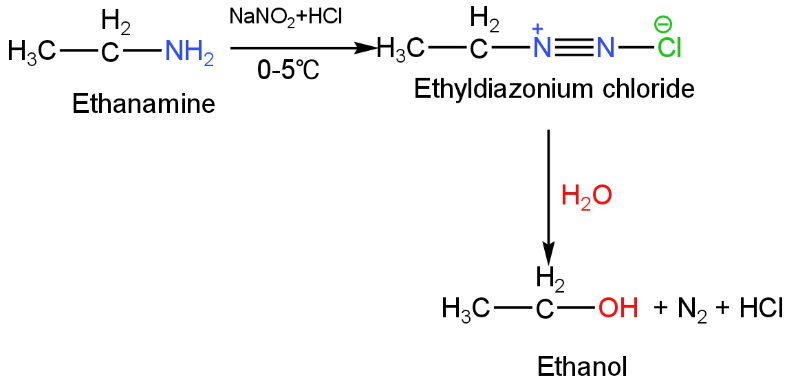
Which of the following on hydrolysis forms acetic acid
A.\[{\rm{C}}{{\rm{H}}_{\rm{3}}}{\rm{CN}}\]
B.\[{\rm{C}}{{\rm{H}}_{\rm{3}}}{\rm{OH}}\]
C.\[{{\rm{C}}_{\rm{2}}}{{\rm{H}}_{\rm{5}}}{\rm{OH}}\]
D.\[{{\rm{C}}_{\rm{2}}}{{\rm{H}}_{\rm{5}}}{\rm{N}}{{\rm{H}}_2}\]
Answer
219k+ views
Hint: Hydrolysis refers to the breaking down of chemical bonds by a molecule of water. Water or hydroxyl ion acts as a nucleophile in this type of reaction.
Complete Step by Step Solution:
Acetic acid, also recognized as ethanoic acid, is an acidic, uncoloured liquid.
It is the simplest carboxylic acid containing two carbon atoms and thus has the name 'ethanoic acid'.
A. \[{\rm{C}}{{\rm{H}}_{\rm{3}}}{\rm{CN}}\]
This is ethanenitrile or acetonitrile also known as methyl cyanide.
This is an uncoloured liquid and is the simplest organic nitrile.
The acidic hydrolysis of acetonitrile will produce acetic acid.
This hydrolysis happens in the presence of hydrochloric acid.
The initial step involves the formation of ethanamide.
The next step involves the formation of ethanoic acid and ammonium chloride.
The reaction happens as follows: \[{\rm{C}}{{\rm{H}}_{\rm{3}}}{\rm{CN + 2}}{{\rm{H}}_{\rm{2}}}{\rm{O + HCl}} \to {\rm{C}}{{\rm{H}}_{\rm{3}}}{\rm{COOH + N}}{{\rm{H}}_{\rm{4}}}{\rm{Cl}}\]
So, A is correct.
B. \[{\rm{C}}{{\rm{H}}_{\rm{3}}}{\rm{OH}}\]
This is methanol or methyl alcohol.
This is the simplest organic alcohol compound.
Methanol on hydrolysis does not give acetic acid.
So, B is incorrect.
C. \[{{\rm{C}}_{\rm{2}}}{{\rm{H}}_{\rm{5}}}{\rm{OH}}\]
This is ethanol or ethyl alcohol.
This is the next organic alcohol compound after methanol.
Ethanol on hydrolysis produces ethanal or acetaldehyde.
The reaction occurs as follows:

Image: Hydrolysis of ethanol
This does not produce acetic acid as the product.
So, C is incorrect.
D. \[{{\rm{C}}_{\rm{2}}}{{\rm{H}}_{\rm{5}}}{\rm{N}}{{\rm{H}}_2}\]
This is ethanamine or ethylamine.
It is a simple amine compound.
Ethylamine on diazotization by nitrous acid preceded by hydrolysis will give ethanol.
When this compound is treated with sodium nitrite and hydrochloric acid, the amine group is transformed into ethyl diazonium salt which then on hydrolysis will give ethanol.
The reaction happens as follows:

Image: Reaction of ethyl amine with nitrous acid.
So, this compound on hydrolysis will not give acetic acid.
So, D is incorrect.
So, option A is correct.
Note: Acetylene in the reaction with HgOH and dilute sulfuric acid leads to the formation of vinyl alcohol. Vinyl alcohol tautomerizes to form acetaldehyde. Acetaldehyde on oxidation forms acetic acid.
Complete Step by Step Solution:
Acetic acid, also recognized as ethanoic acid, is an acidic, uncoloured liquid.
It is the simplest carboxylic acid containing two carbon atoms and thus has the name 'ethanoic acid'.
A. \[{\rm{C}}{{\rm{H}}_{\rm{3}}}{\rm{CN}}\]
This is ethanenitrile or acetonitrile also known as methyl cyanide.
This is an uncoloured liquid and is the simplest organic nitrile.
The acidic hydrolysis of acetonitrile will produce acetic acid.
This hydrolysis happens in the presence of hydrochloric acid.
The initial step involves the formation of ethanamide.
The next step involves the formation of ethanoic acid and ammonium chloride.
The reaction happens as follows: \[{\rm{C}}{{\rm{H}}_{\rm{3}}}{\rm{CN + 2}}{{\rm{H}}_{\rm{2}}}{\rm{O + HCl}} \to {\rm{C}}{{\rm{H}}_{\rm{3}}}{\rm{COOH + N}}{{\rm{H}}_{\rm{4}}}{\rm{Cl}}\]
So, A is correct.
B. \[{\rm{C}}{{\rm{H}}_{\rm{3}}}{\rm{OH}}\]
This is methanol or methyl alcohol.
This is the simplest organic alcohol compound.
Methanol on hydrolysis does not give acetic acid.
So, B is incorrect.
C. \[{{\rm{C}}_{\rm{2}}}{{\rm{H}}_{\rm{5}}}{\rm{OH}}\]
This is ethanol or ethyl alcohol.
This is the next organic alcohol compound after methanol.
Ethanol on hydrolysis produces ethanal or acetaldehyde.
The reaction occurs as follows:

Image: Hydrolysis of ethanol
This does not produce acetic acid as the product.
So, C is incorrect.
D. \[{{\rm{C}}_{\rm{2}}}{{\rm{H}}_{\rm{5}}}{\rm{N}}{{\rm{H}}_2}\]
This is ethanamine or ethylamine.
It is a simple amine compound.
Ethylamine on diazotization by nitrous acid preceded by hydrolysis will give ethanol.
When this compound is treated with sodium nitrite and hydrochloric acid, the amine group is transformed into ethyl diazonium salt which then on hydrolysis will give ethanol.
The reaction happens as follows:

Image: Reaction of ethyl amine with nitrous acid.
So, this compound on hydrolysis will not give acetic acid.
So, D is incorrect.
So, option A is correct.
Note: Acetylene in the reaction with HgOH and dilute sulfuric acid leads to the formation of vinyl alcohol. Vinyl alcohol tautomerizes to form acetaldehyde. Acetaldehyde on oxidation forms acetic acid.
Recently Updated Pages
Is PPh3 a strong ligand class 12 chemistry JEE_Main

Full name of DDT is A 111trichloro22bispchlorophenyl class 12 chemistry JEE_Main

Sodium acetate on heating with soda lime produce A class 12 chemistry JEE_Main

Find the isoelectric point pI of Lysine A 556 B 974 class 12 chemistry JEE_Main

The order of basicity among the following compounds class 12 chemistry JEE_Main

The number of isomers in C4H10O are a7 b8 c6 d5 class 12 chemistry JEE_Main

Trending doubts
JEE Main 2026: Application Form Open, Exam Dates, Syllabus, Eligibility & Question Papers

Derivation of Equation of Trajectory Explained for Students

Hybridisation in Chemistry – Concept, Types & Applications

Understanding the Angle of Deviation in a Prism

Understanding Collisions: Types and Examples for Students

Understanding Atomic Structure for Beginners

Other Pages
NCERT Solutions For Class 12 Chemistry Chapter 1 Solutions - 2025-26

NCERT Solutions for Class 12 Chemistry Chapter Chapter 7 Alcohol Phenol and Ether

NCERT Solutions ForClass 12 Chemistry Chapter Chapter 8 Aldehydes Ketones And Carboxylic Acids

JEE Advanced Marks vs Ranks 2025: Understanding Category-wise Qualifying Marks and Previous Year Cut-offs

Haloalkanes and Haloarenes Class 12 Chemistry Chapter 6 CBSE Notes - 2025-26

Solutions Class 12 Chemistry Chapter 1 CBSE Notes - 2025-26




